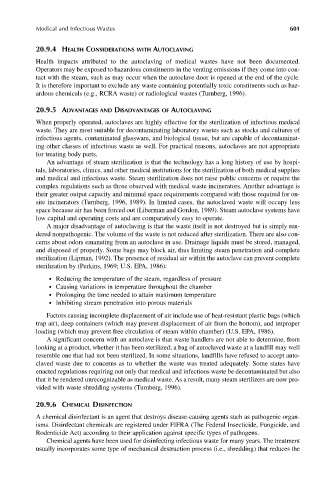Page 630 - Materials Chemistry, Second Edition
P. 630
CAT3525_C20.qxd 1/27/2005 12:54 PM Page 601
Medical and Infectious Wastes 601
20.9.4 HEALTH CONSIDERATIONS WITH AUTOCLAVING
Health impacts attributed to the autoclaving of medical wastes have not been documented.
Operators may be exposed to hazardous constituents in the venting emissions if they come into con-
tact with the steam, such as may occur when the autoclave door is opened at the end of the cycle.
It is therefore important to exclude any waste containing potentially toxic constituents such as haz-
ardous chemicals (e.g., RCRA waste) or radiological wastes (Turnberg, 1996).
20.9.5 ADVANTAGES AND DISADVANTAGES OF AUTOCLAVING
When properly operated, autoclaves are highly effective for the sterilization of infectious medical
waste. They are most suitable for decontaminating laboratory wastes such as stocks and cultures of
infectious agents, contaminated glassware, and biological tissue, but are capable of decontaminat-
ing other classes of infectious waste as well. For practical reasons, autoclaves are not appropriate
for treating body parts.
An advantage of steam sterilization is that the technology has a long history of use by hospi-
tals, laboratories, clinics, and other medical institutions for the sterilization of both medical supplies
and medical and infectious waste. Steam sterilization does not raise public concerns or require the
complex regulations such as those observed with medical waste incinerators. Another advantage is
their greater output capacity and minimal space requirements compared with those required for on-
site incinerators (Turnberg, 1996, 1989). In limited cases, the autoclaved waste will occupy less
space because air has been forced out (Liberman and Gordon, 1989). Steam autoclave systems have
low capital and operating costs and are comparatively easy to operate.
A major disadvantage of autoclaving is that the waste itself is not destroyed but is simply ren-
dered nonpathogenic. The volume of the waste is not reduced after sterilization. There are also con-
cerns about odors emanating from an autoclave in use. Drainage liquids must be stored, managed,
and disposed of properly. Some bags may block air, thus limiting steam penetration and complete
sterilization (Lipman, 1992). The presence of residual air within the autoclave can prevent complete
sterilization by (Perkins, 1969; U.S. EPA, 1986):
● Reducing the temperature of the steam, regardless of pressure
● Causing variations in temperature throughout the chamber
● Prolonging the time needed to attain maximum temperature
● Inhibiting stream penetration into porous materials
Factors causing incomplete displacement of air include use of heat-resistant plastic bags (which
trap air), deep containers (which may prevent displacement of air from the bottom), and improper
loading (which may prevent free circulation of steam within chamber) (U.S. EPA, 1986).
A significant concern with an autoclave is that waste handlers are not able to determine, from
looking at a product, whether it has been sterilized; a bag of autoclaved waste at a landfill may well
resemble one that had not been sterilized. In some situations, landfills have refused to accept auto-
claved waste due to concerns as to whether the waste was treated adequately. Some states have
enacted regulations requiring not only that medical and infectious waste be decontaminated but also
that it be rendered unrecognizable as medical waste. As a result, many steam sterilizers are now pro-
vided with waste shredding systems (Turnberg, 1996).
20.9.6 CHEMICAL DISINFECTION
A chemical disinfectant is an agent that destroys disease-causing agents such as pathogenic organ-
isms. Disinfectant chemicals are registered under FIFRA (The Federal Insecticide, Fungicide, and
Rodenticide Act) according to their application against specific types of pathogens.
Chemical agents have been used for disinfecting infectious waste for many years. The treatment
usually incorporates some type of mechanical destruction process (i.e., shredding) that reduces the

